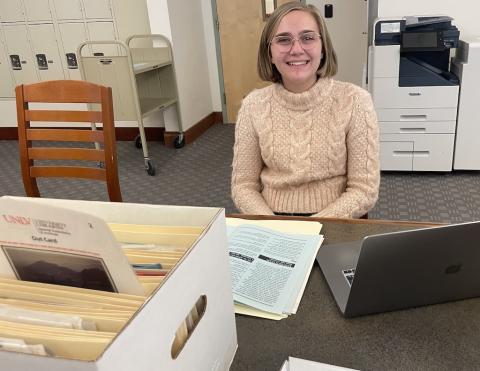
Our Researcher Profile series highlights researchers and who have used resources in Special Collections & Archives for a variety of projects ranging from articles and books to exhibits and documentaries and more.
This week's post focuses on the work of Ana Cwietniewicz, an international relations major at Pomona College in Claremont, CA.
Tell us a little bit about the project (book, exhibit, article, documentary, report) you researched in Special Collections & Archives.
I’m currently working on my undergraduate thesis at Pomona College. This thesis examines the history of the
Nevada-Semipalatinsk Movement, a transnational collaboration between anti-nuclear activists in the United States and the Soviet Union. Drawing on archival documents from both Kazakhstan and the U.S., my research explores the movement’s role in the closure of the Semipalatinsk Testing Site and its influence on the development of Kazakhstani civil society following the collapse of the Soviet Union.
How did you hear about Special Collections & Archives?
After deciding to focus my thesis on the Nevada-Semipalatinsk Movement, I began to read the existing literature on the topic. Several articles I came across during my preliminary research cited documents from UNLV’s Special Collections & Archives, which piqued my interest.
What resources, collections or materials from Special Collections & Archives were most impactful for your research?
The Nevada Desert Experience Records were especially impactful for my research, as the collection provided valuable insight into the depth of collaboration between Kazakhstani and American anti-nuclear activists.
How did you become interested in the topic(s) you wrote about?
Last spring, I had the opportunity to study abroad in Almaty, Kazakhstan. I first learned about the Nevada-Semipalatinsk Movement in my Kazakhstani history class. Although the instructor only briefly mentioned this movement, I was intrigued and wanted to learn more. When I returned to my college in the fall, I knew I wanted to pursue a project that would allow me to draw on the Russian language skills and knowledge of Central Asia that I had gained in Kazakhstan. This research project turned out to be the perfect fit, enabling me to leverage these skills to explore a significant yet often overlooked chapter in transnational anti-nuclear activism.
What surprised you the most about your research in Special Collections & Archives?
I was surprised by the diversity of materials that I encountered in Special Collections and Archives. The Nevada Desert Experience Records contained a fascinating range of materials, such as newspaper clippings, reports, brochures, postcards, and even an original headband from the Nevada-Semipalatinsk Movement!
What advice would you give to other authors/researchers using Special Collections & Archives? (Otherwise known as what I wish someone had told me before I visited Special Collections & Archives)
Take pictures of everything. You may not initially think that a particular document will be helpful for your project, but having a record of everything can be invaluable as you move forward in the research process. It's better to take too many photos and notes than to take too few and miss out on what could be an important “clue” in answering your research question.
How did your research in Special Collections & Archives change your perceptions about Las Vegas?
Before my research trip, I had never been to Las Vegas, but mostly associated the city with its entertainment and tourism industries. However, my research in Special Collections & Archives completely changed my perception of Las Vegas, as I learned about the history of nuclear testing in Nevada and the activism that emerged in response.


